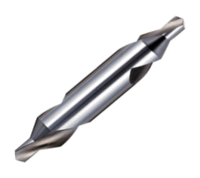Centre Drill: Difference between revisions
From DT Online
mNo edit summary |
(Corrected Link) |
||
| Line 3: | Line 3: | ||
When drilling down the centre of a bar held in a '''[[Centre Lathe|Lathe]]''' '''chuck''' however, a | When drilling down the centre of a bar held in a '''[[Centre Lathe|Lathe]]''' '''chuck''' however, a [http://wiki.dtonline.org/index.php/File:CentreDrill.png '''Centre Drill'''] can be used. These are short and rigid enough to mark the bar centre and drill a small pilot hole. Also known as '''Slocombe Drills''' they are used also to create the countersink required to locate a tailstock centre when turning between centres - which is the purpose for which they were originally designed. | ||
[[Category:Drilling and Boring]] | [[Category:Drilling and Boring]] | ||
Revision as of 09:04, 24 April 2016
When drilling metal, it is advisable first to mark the hole centre with a Centre Punch to stop Twist Drills wandering about the surface.
When drilling down the centre of a bar held in a Lathe chuck however, a Centre Drill can be used. These are short and rigid enough to mark the bar centre and drill a small pilot hole. Also known as Slocombe Drills they are used also to create the countersink required to locate a tailstock centre when turning between centres - which is the purpose for which they were originally designed.
